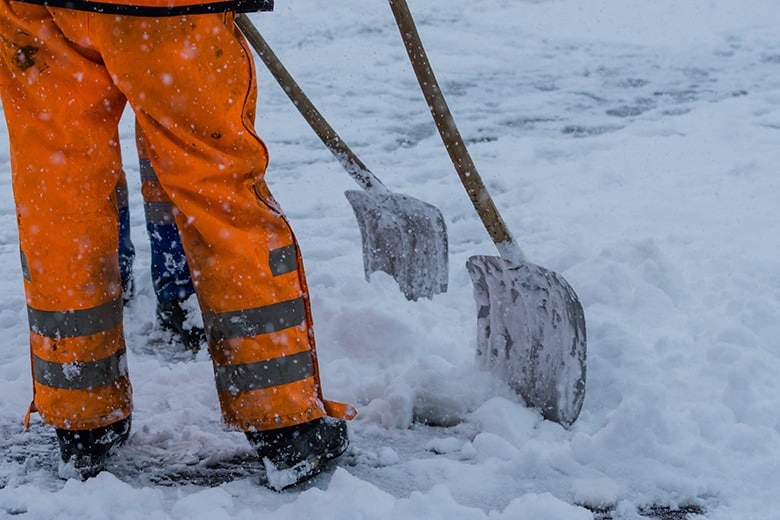Plan, equip, train. That’s the Occupational Safety and Health Administration (OSHA)’s message to employers as companies brace for the dead of winter. It is the law that employers provide employees a work environment free from known hazards that cause, or are likely to cause, death or serious physical harm. This includes dangerously low temperatures during winter months, which can result in an employee suffering from cold stress while working outdoors in inclement weather.
Cold stress occurs when icy environmental conditions drive down the skin temperature and ultimately the inner body temperature, causing a person to freeze from the outside in. This could manifest in many ways, including trench foot, frostbite, and hypothermia. Cold stress can result in permanent tissue damage and often death when not addressed immediately.
To protect workers from suffering cold stress, OSHA emphasizes that employers ensure the following:
Offer proper cold-weather training. At the very least, employers must train employees to identify cold stress and cold-related illnesses and injuries. They should recognize and monitor cold stress symptoms in themselves and others and dress accordingly for cold, wet, and windy conditions. In addition, they should know how to seek and give first aid or call for additional medical assistance in an emergency. Workers also must be trained to identify cold-related environmental hazards such as icy and slippery roads and surfaces, wind chill, and downed power lines.
Provide engineering controls. Engineering controls in the workplace, such as radiant heaters and shields to control wind chill, effectively prevent cold-related illnesses and injuries. Additionally, aerial lifts and ladders to de-ice higher surfaces such as roofs can help ensure that workers don’t slip and fall.
Implement safe work practices. According to OSHA, safe work practices that employers can implement to protect workers from cold-related harm include:
- Providing workers with the proper tools and equipment to do their jobs.
- Developing work plans that identify potential hazards and the safety measures used to protect workers.
- Scheduling maintenance and repair jobs for warmer months.
- Avoiding exposure to freezing temperatures when possible.
- Limiting the amount of time spent outdoors on extremely cold days.
- Using relief workers to assign extra workers for long, demanding jobs.
- Providing warm areas for use during break periods.
- Providing warm liquids (no alcohol) to workers.
- Monitoring workers who are at risk of cold stress.
- Monitoring the weather conditions during a winter storm, having a reliable means of communicating with workers, and stopping work or evacuating when necessary.
- Acclimatizing new workers and those returning after time away from work by gradually increasing their workload and allowing more frequent breaks in warm areas, as they build up a tolerance for working in the cold environment.
- Having a means of communicating with workers, especially in remote areas.
- Knowing how the community warns the public about severe weather: outdoor sirens, radio, and television.
Consider protective clothing that provides warmth. Though employers are not required to provide employees with “ordinary” protective clothing from the cold such as hats, gloves, and jackets, employers must provide personal protective equipment (PPE) to protect employees from getting injured in a cold-related accident. Most commonly, a slip and fall. OSHA also highly advises that employers provide employees who work outside in the cold with protective winter clothing like winter coats and gloves – and many of them do.
If you will be working in damp, cold, or windy conditions this winter, here is what you should remember, according to OSHA:
- Your employer should ensure that you know the symptoms of cold stress.
- Monitor your physical condition and that of your coworkers.
- Dress appropriately for the cold.
- Stay dry in the cold because moisture or dampness (i.e., sweat) can increase the rate of heat loss from the body.
- Keep extra clothing (including underwear) handy if you get wet and need to change.
- Drink warm sweetened fluids (no alcohol).
- Use proper engineering controls, safe work practices, and personal protective equipment (PPE) provided by your employer.
Prioritizing Workers’ Health and Safety in The Carolinas Year-Round
An employer’s legal responsibility is to make and maintain a safe work environment for their employees. This holds especially true for those who work outside in inclement or otherwise extreme weather conditions. Are you an employee who has experienced cold-related injuries or illnesses due to your employer’s negligence? Alternatively, are you an employer with questions on cold-weather training? The Workers’ Compensation attorneys at Grimes Teich Anderson can help. Fill out and submit a form on our website or call our office toll-free at 800-533-6845 for a free legal consultation today.

